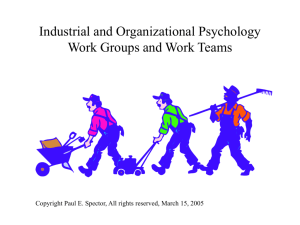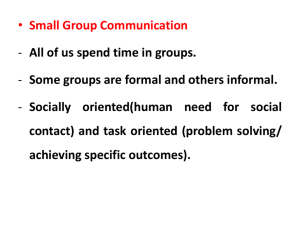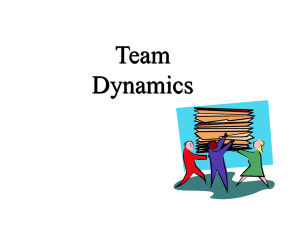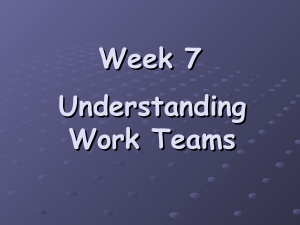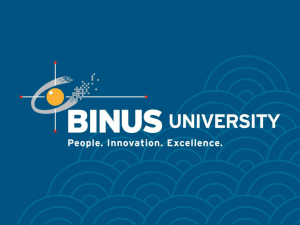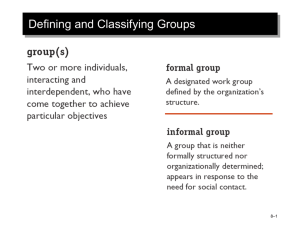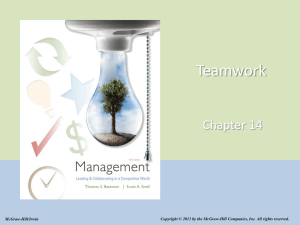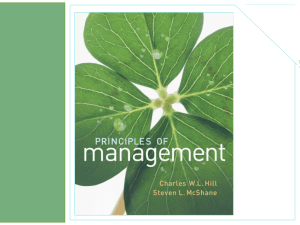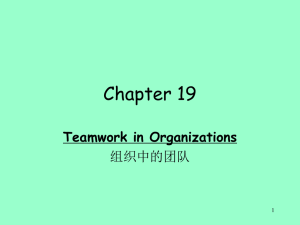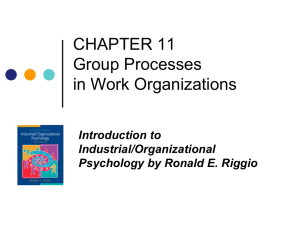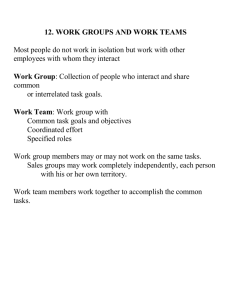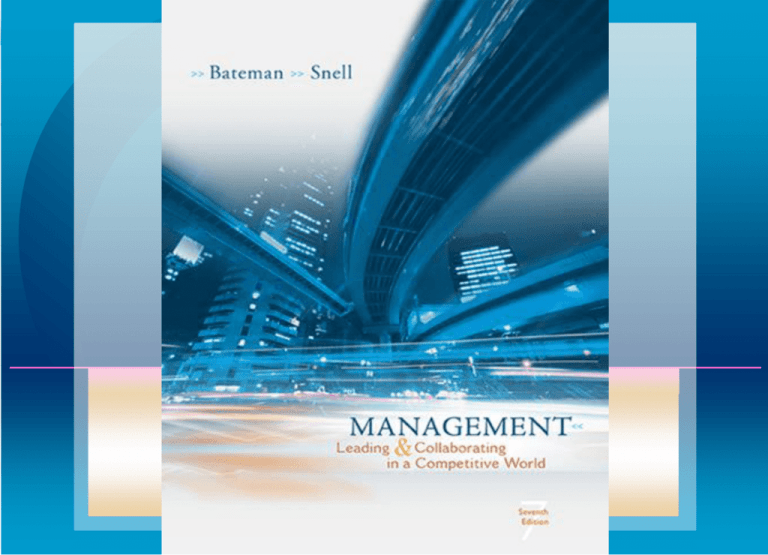
14-1
Chapter
14
Teamwork
McGraw-Hill/Irwin
Management, 7/e
Copyright © 2007 The McGraw-Hill Companies, Inc. All rights reserved.
14-3
Learning Objectives
After Studying Chapter 14, You will know
How teams contribute to your organization’s
effectiveness.
What makes the new team environment
different from the old.
How groups become teams.
Why groups sometimes fail.
How to build an effective team.
How to manage your team’s relationships with
other teams.
How to manage conflict.
14-4
The Contributions of Teams
Well-managed teams are powerful forces that
can deliver all desired results
Teams can increase productivity, improve
quality, and reduce costs
Teams can enhance speed and be powerful
forces for innovation and change
Teams can be useful learning mechanisms
Team members can provide one another with
feedback, identify opportunities for growth and
development, train, coach, and mentor
14-5
The New Team Environment
The words group and team
are often used
interchangeably hover
they are not the same
A working group is a
collection of people who
work in the same area
A team is formed of people
with complementary skills
who trust one another and
are committed to a
common purpose, common
performance goals, and a
common approach for
which they hold
themselves mutually
accountable.
14-6
The New Team Environment
14-7
Types of Teams
Work teams make or do things such as manufacture,
assemble, sell, or provide service
Project and development teams work on long-term
projects but disband once the work is completed
Parallel teams operate separately from the regular
work structure of the firm on a temporary basis
Management teams coordinate and provide direction
to the subunits under their jurisdiction and integrate
work among subunits
Transnational teams are work teams composed of
multinational members whose activities span multiple
countries
14-8
Self Managed Teams
Self-managed teams are autonomous work
groups in which workers ware trained to do
all or most of the jobs in a unit, have no
immediate supervisor, and make decisions
previously made by first-line supervisors
14-9
Self Managed Teams
Traditional Work Groups have no managerial
responsibilities
Quality circles are voluntary groups of people drawn
from various production teams who make suggestions
about quality
Semiautonomous work groups make decisions about
managing and carrying out major production activities
Autonomous work groups control decisions about and
execution of a complete range of tasks
14-10
How Groups Become Real Teams
Groups become true
teams via
Basic group
activities
Passage of time
Team development
activities
14-11
Why Groups Sometimes Fail
Failure lies in not knowing and doing what
makes teams successful
Team is often just a word used by
management to describe merely putting people
into groups
Teams sometimes are launched with little or
no training or support system
Teams are not truly empowered
14-12
Building Effective Teams
Team effectiveness is defined by three
criteria
Productive output of the team meets or
exceeds the standards of quantity and quality
Team members realize satisfaction of their
personal needs
Team members remain committed to working
together again
14-13
Motivating Teamwork
When working in a group individuals may display
one of the following characteristics
Social loafing occurs when individuals work less
hard and are less productive in a group
Social facilitation effect occurs when individuals
work harder when in a group than when working
alone
To motivate individual members of the team it
helps if:
Group members are held accountable
Rewards are tied to team performance
The team’s task is motivating
14-14
Building Effective Teams: Norms and
Roles
Norms are shared beliefs about how people
should think and behave
Roles are different sets of expectations for
how different individuals should behave
Task specialist is an individual who has more
advanced job-related skills and abilities than
other group members
Team maintenance specialist is an individual
who develops and maintains team harmony
14-15
Building Effective Teams: Norms and
Roles
Leaders may perform one of the following
roles
Relating includes exhibiting more social and
political awareness
Scouting means seeking information from
managers, peers, and specialists
Persuading means not only influencing the
team, but also obtaining external support
Empowerment includes delegating authority,
being flexible regarding team decisions, and
coaching
14-16
Building Effective Teams: Cohesiveness
Cohesiveness refers to how attractive the
team is to its members, how motivated the
members are to remain in the team, and the
degree to which team members influence one
another
Cohesiveness is important because
It contributes to member satisfaction
It has a major impact on performance
14-17
Building Effective Teams: Cohesiveness
14-18
Building Cohesiveness and High
Performance Norms
Recruit members with similar attitudes,
values and backgrounds
Maintain high entrance and socialization
standards
Keep the team small
Help the team succeed, and publicize its
success
Present a challenge from outside the team
Tie rewards to team performance
14-19
Managing Lateral Relationships
Gatekeeper is a team member who keeps abreast
of current developments and provides the team
with relevant information
Informing is a team strategy that entails making
decisions with the team and then informing
outsiders of its intentions
Parading is a team strategy that entails
simultaneously emphasizing internal team
building and achieving external visibility
Probing is a team strategy that requires team
members to interact frequently with outsiders,
diagnose their needs, and experiment with
solutions
14-20
Lateral Role Relationships
Work-flow relationships emerge as materials
are passed from one group to another
Service relationships exist when top
management centralizes an activity to which
a large number of other units must gain
access
Advisory relationships are created when
teams with problems call on centralized
sources of expert knowledge
14-21
Lateral Role Relationships
Audit relationships develop when people not
directly in the chain of command evaluate
the methods and performances of other
teams
Stabilization relationships involve auditing
before the fact
Liaison relationships involve intermediaries
between teams
14-22
Conflict
The complex maze of interdependencies
throughout organizations provides boundless
opportunity for conflict to arise
Many things cause great potential for
destructive conflict
The sheer number and variety of contacts
Ambiguities in jurisdiction and responsibility
Differences in goals
Inter-group competition for scarce resources
Different perspectives held by members of
different unites
14-23
Conflict
People believe they have benefited from a
conflict when
A new solution is implemented, the problem is
solved, and it is unlikely to emerge again
Work relationships have been strengthened
and people believe they can work together
productively in the future
14-24
Conflict Styles
Avoidance is a common reaction to conflict in
which people do nothing to satisfy
themselves or others
Accommodation means cooperating on behalf
of the other party but not being assertive
about your own interests
Compromise involves moderate attention to
both parties concerns
14-25
Conflict Styles
Competing is a highly competitive response
in which people focus strictly on their own
wishes and are unwilling to recognize the
other person’s concerns
Collaboration emphasizes both cooperation
and assertiveness, the goal is to maximize
satisfaction for both parties
14-26
Conflict Styles
14-27
Conflict
When conflict arises the best solutions come
from collaboration and focusing on super
ordinate goals
Super ordinate goals are higher-level goals
that take priority over specific individual or
group goals
14-28
Being a Mediator
Managers spend a lot of time trying to resolve
conflict between other people
This is known as being a mediator
Four step strategy
Investigate the dispute
Decide how to resolve the dispute
Take action by explaining the decision and
reasoning
Follow up by making sure everyone
understands the solution
14-29
Looking Ahead
Chapter 15 Communicating
The important advantages of two-way
communication.
Communication problems to avoid.
When and how to use the various communication
channels.
Ways to become a better “sender” and “receiver” of
information.
How to improve downward, upward, and horizontal
communication.
How to work with the company grapevine.
The advantages and characteristics of the
boundaryless organization.
14-30
Group Activities
Group activities include
Forming – group members attempt to lay down
ground rules for acceptable behavior
Storming – hostilities and conflict arise as people
jockey for positions of power and status
Norming – group members agree on their shared
goals and norms
Performing – the group channels its energies into
performing its tasks
Return
14-31
Passage of Time
Groups pass through
critical periods, or
times, when they are
particularly open to
formative
experiences
The initial meeting
when rules, roles
are established
Meeting the initial
deadline
Return
14-32
Developmental Sequence
Return

